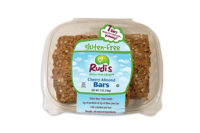Raising the food bar
Innovations, broader appeal keep food bars competitive


|
If making food bars were a final exam, the cereal and the energy bar makers each would be called out for copying. Both categories are drawing product innovation inspiration from each other these days, and unlike in school, the tactic seems to be working out well.
Food bar sales reportedly reached $5.7 billion in 2011, according to Food Bars in the U.S., a March report released by market research firm Packaged Facts. That’s compared to the $5.3 billion in sales the sector saw in 2010.
Although the report classifies food bars into two categories — cereal/granola bars and energy/nutrition bars — it notes that the distinction between them is blurring.
Specifically, cereal/granola bars are focusing more on incorporating nutritional and functional ingredients (such as added protein or fiber), while energy/nutrition bars are focusing on adding decadent formulations to make their products more appetizing.
In the cereal bar sector, manufacturers are targeting consumers looking for a workout energy boost, a nutritious snack, or a fast meal substitute. Throughout the past five years, sales of cereal bars with reduced calories, fat or sugar have risen, although the number of products introduced with those claims has decreased.
Meanwhile, in the energy/nutrition bar category, new flavors and ingredients are being used to improve both the taste and texture of bars. Among the functional ingredients manufacturers are using to vary the nutrition bar formula are CoQ10, L-carnitine, omega-3, resveratrol, and vitamin K2.
Beyond that, increased marketing, new products and innovative delivery formats have helped spurred the growth. Meanwhile, the category also has benefited from an ever-hazy line between meals and snacks as well as consumers looking for spur-of-the moment eating options and easy ways to manage portion control.
As for the future, manufacturers are looking to address more sophisticated concerns, such as creating products to restore nutrition lost in weight-loss programs, while other food bar introductions have high-protein, low-carbohydrate or balanced-gastrointestinal formulations.
Looking for a reprint of this article?
From high-res PDFs to custom plaques, order your copy today!






